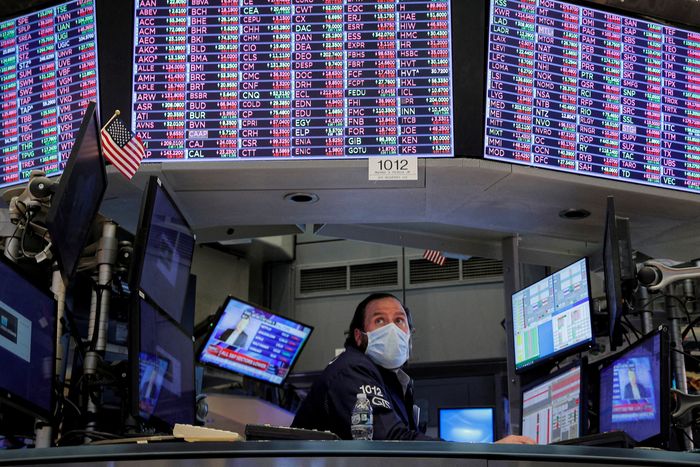U.S. stocks fell on Thursday, as a late-afternoon selloff erased what had been an early rally, showing that investors are still concerned about the prospects of tightening monetary policy and slowing growth.
The Nasdaq Composite Index dropped 186.23 points, or 1.3%, to 14154.02, a day after a tech selloff dragged down indexes. The index fell more than 3% from its intraday high to its low. It is now down nearly 12% from its November high.
The Dow Jones Industrial Average lost 313.26 points, or 0.9%, to 34715.39. It was the index’s fifth consecutive down session, its longest such streak since September. The blue-chip index has fallen in nine of the past 11 sessions. The S&P 500 dropped 50.03 points, or 1.1%, to 4482.73.
The afternoon selloff wasn’t surprising, said Sameer Samana, a strategist at Wells Fargo Investment Institute. Even after the recent pullback, selloffs usually need time to find a true bottom. Moreover, on a day like Thursday, it’s likely some traders decided to sell into the early gains in order to cut some of their losses from the prior selloffs.
“This is just how markets bottom,” he said. “It just takes a few days.”
Indeed, the choppy trading shows investors are trying to gauge how far this selloff will go. On Wednesday, the ragged, weekslong selloff pushed the Nasdaq down more than 10% below its record close, putting it in correction territory. Those kinds of plateaus usually bring in bargain hunters, but on its own is no indication a selloff is over, observers say.
“Whenever we see equities churn lower, as they have this year, we are mindful that the risk of a meltdown grows rather than diminishes,” said Nicholas Colas, the founder of analytics firm DataTrek Research.
Faced with the prospect of multiple interest-rate rises, cooling growth and inflation at multidecade highs, investors have been reassessing the pandemic-era playbook that focused on outsize gains for growth stocks, such as in tech. In recent sessions, investors have rotated into sectors expected to perform better in the coming year, such as financials and energy.
Investors are selling government bonds in anticipation of higher interest rates, pushing up yields, and in the process, pressuring tech companies, whose future earnings become less attractive when compared with bonds with rising yields.
“I don’t see a whole lot in the market that is really alarming me. There is no one out there saying ‘run for the hills,’ but there are those saying they are going to take off risk and reposition to other areas of the market,” said Kara Murphy, chief investment officer of Kestra Holdings.

The technology-heavy Nasdaq Composite shed 1.1% on Wednesday.
Photo: BRENDAN MCDERMID/REUTERS
The day brought a spate of economics reports. Weekly jobless claims jumped to 286,000 from 231,000 as businesses contend with Omicron-related disruptions. Existing-home sales in December fell 7.1% from a year ago, though home sales for 2021 were at a 15-year high.
The yield on the 10-year U.S. Treasury note rose to 1.833%, adding to steady gains in recent weeks. Benchmark German bund yields fell further into negative territory, a day after they briefly turned positive. The yield on the 10-year German government bond slipped to minus 0.015% Thursday from minus 0.014% Wednesday.
Among U.S. equities, shares of Peloton Interactive fell 24% to $24.22 after CNBC reported the company is pausing production of its bikes and other connected-fitness products amid lower demand from consumers.
Dow component Travelers Cos. rose 3.2% to $165.18 after reporting record net income for the fourth quarter. American Airlines Group fell 3.2% to $16.76 even after the carrier said it had trimmed its losses.
Shares of Netflix fell 19% after the market close, after the company reported 8.3 million subscribers joined its platform in the latest quarter, slightly missing its own forecast. Investors were more focused on that number and the company’s forecast for the current quarter, which projected slower subscriber growth, than the actual earnings, which topped analyst forecasts.
Hong Kong-listed Chinese stocks jumped after an interest-rate cut by China’s central bank lifted shares of property developers and tech giants. The Hang Seng Index rose 3.4%, while mainland China’s Shanghai Composite Index edged down 0.1%. Elsewhere in Asia, the Nikkei 225 rose 1.1%. The pan-continental Stoxx Europe 600 edged up 0.5%.
U.S. crude-oil futures fell 0.1% to $86.90 a barrel, but like equities were volatile during the day. This follows a rally partly driven by the potential for supply disruptions in Russia and the Middle East. On Wednesday, crude futures hit their highest level since October 2014. Observers say the next big target is $100 a barrel.
Write to Will Horner at william.horner@wsj.com
Copyright ©2022 Dow Jones & Company, Inc. All Rights Reserved. 87990cbe856818d5eddac44c7b1cdeb8








